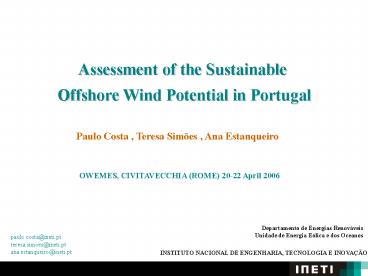projecto PPEPP - PowerPoint PPT Presentation
1 / 23
Title:
projecto PPEPP
Description:
Assessment of the Sustainable. Offshore Wind Potential in Portugal ... Gayno-Seaman (PBL); RRTM (radiation); GRELL (cumulus); SIMPLE ICE (microphysics) ... – PowerPoint PPT presentation
Number of Views:54
Avg rating:3.0/5.0
Title: projecto PPEPP
1
Assessment of the Sustainable Offshore Wind
Potential in Portugal
Paulo Costa , Teresa Simões , Ana Estanqueiro
OWEMES, CIVITAVECCHIA (ROME) 20-22 April 2006
Departamento de Energias Renováveis Unidade de
Energia Eólica e dos Oceanos
paulo.costa_at_ineti.pt teresa.simoes_at_ineti.pt ana.es
tanqueiro_at_ineti.pt
INSTITUTO NACIONAL DE ENGENHARIA, TECNOLOGIA E
INOVAÇÃO
2
1- Main objective and rule
slide 2 of 22
3
Main objective and rule
- Objective
- To identify coastal regions in Portugal with
sustainability indicators for wind potential
offshore development - Main Rule
- Help developers to plan offshore wind parks along
coastal areas taking into account the economic
and technical feasibility of the project
subjected to the following factors - Distance to coast less than 15km
- Sea depth less than 40m
- A gently slope between bathymetry 20 and 40m
- Good resource assessment available
- Close to the available electric grid connections.
slide 3 of 22
4
2- Offshore assessment and methodology
slide 4 of 22
5
Offshore assessment and methodology
- A reasonable wind potential assessment was made
by making a high resolution (3X3km) long term
simulation with the popular MM5 atmospheric
mesoscale model - A set of a full one year of Reanalysis data (at
intervals of 6h) from NCARs Mass Storage
Systems ingested to MM5 - Simulate the power output field (h/year) for two
turbine models GEWE 1500SL (rotor with 60m
height) and VESTAS V80 (80m height)
slide 5 of 22
6
Offshore assessment and methodology
- Inter annual variability applied to simulated
wind and power fields computed with help of 4
anemometric long term stations located in
mainland Portugal - Digitized bathymetric lines up to 40m depth
- Use spatial operations available in GIS
(Geographic Information Systems) software to
obtain favorable areas.
slide 6 of 22
7
3- Set of numerical simulations
slide 7 of 22
8
Set of numerical simulations
Four one-way nested domains with resolutions of
81km 27km 9km and 3km
High resolution MM5 domain (3X3km) used for
offshore assessment
slide 8 of 22
9
Set of numerical simulations
- Parameterization schemes previously selected by
making a couple of control simulations in order
to minimize the differences between observed and
simulated wind speed and direction values - Gayno-Seaman (PBL)
- RRTM (radiation)
- GRELL (cumulus)
- SIMPLE ICE (microphysics)
- NOAH (soil model)
- Selected
- numerical
- schemes
slide 9 of 22
10
Set of numerical simulations
INETIs long term wind stations used in this work
for validation purposes and to compute intra
annual variability
slide 10 of 22
11
4- Some numerical results
slide 11 of 22
12
Some numerical results
Simulated number of hours at full capacity for
two turbine models
MM5 (3X3km)
Intra annual variability accounted
GEWE 1.50 SL 1500 kW H60m
VESTAS V80 2000 kW H80m
slide 12 of 22
13
Some numerical results
Power curves used in MM5 simulations for each
turbine model
Resolution (3X3km)
slide 13 of 22
14
5- GIS operations
slide 14 of 22
15
GIS operations
- Some spatial GIS operations was used to make a
simple query taking into account the following
factors - Distance to coast below 15km
- Sea bathymetry lower than 40m
- A gently slope between 20 and 40m depths
- acceptable wind resource (number of hours at
full capacity great than 2300h/year) - Proximity to the network with available grid
connection capacity.
slide 15 of 22
16
6- GIS results
slide 16 of 22
17
GIS results
Six favourable areas were identified for
each turbine model.
Areas A,B,C to F (capital letters)
GEWE 1.50 SL 1500 kW H60m
VESTAS V80 2000 kW H80m
slide 17 of 22
18
GIS results
A zoom for each selected area
Figueira da Foz
Espinho/Porto
Berlengas/Peniche
Portimão/Albufeira
Bordeira
Estuário do Tejo/Caparica/Tróia
Vila Real de Sto António
slide 18 of 22
19
GIS results
Query results obtained for each selected area
slide 19 of 22
20
7- Concluding remarks
slide 20 of 22
21
Concluding remarks
Unlike previous common public opinions, the
preliminary results of this work enhance some
interesting areas for developing offshore wind
parks in Portugal
Some estuarine regions (e.g. Tagus estuary)
reveal good acceptance values
Therefore, a more sophisticated study must be
realized in order to deal with the presence of
navigation channels, bridges and other
hydro-dynamical estuarine phenomena.
slide 21 of 22
22
Concluding remarks
Results here presented aimed INETI to start a
special monitoring campaign in the Peniche to
Lisbon region in order to validate the results
near west coast of Portugal best resource
assessment available
Berlengas/Peniche
A set of high resolution numerical simulations
are being prepared by INETI involving microscale
and mesoscale models to produce a rigorous and
highly accurate assessment for offshore wind
power in Portugal
FINAL
23
Thank you!































